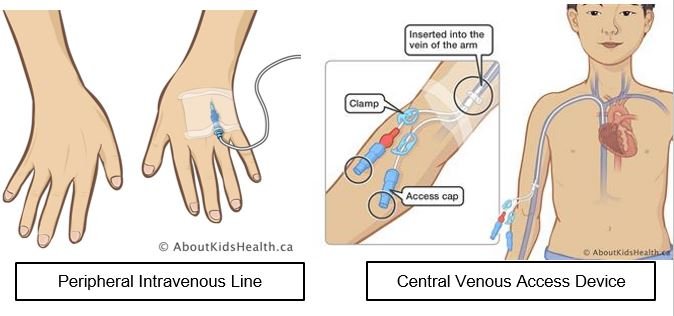HINT: What are continuous ambulatory delivery device (CADD) pumps and how are they used in home and community settings?
Connected Care Quick Hits are up to date and evidence based recommendations for the care of children with medical complexity & technology dependence, from hospital to home.
HINT: What are continuous ambulatory delivery device (CADD) pumps and how are they used in home and community settings?
SITUATION:
This QuickHit was informed by Connected Care Live consults from home and community care providers about the use of CADD pumps for medication administration in home and community settings.
BACKGROUND:
Children with medical complexity may be discharged from hospital to home and community with needs for long-term intravenous therapy such as medication administration, parenteral nutrition, and hydration. Intravenous therapies are administered through vascular access devices including peripheral intravenous lines (PIV) and central venous access devices (CVAD).
CADD pumps are a common type of ambulatory infusion pump used in paediatrics to deliver intravenous therapies in home and community settings. They may also be used for subcutaneous medication delivery. CADD pumps are intended for therapies that either require a continuous rate of infusion or need to be administered multiple times in a day (e.g., every 6 hours) such as antibiotics, pain medications, and parenteral nutrition. Examples of CADD pumps that are used in home and community settings include CADD Solis® and CADD-Legacy® PLUS.
ASSESSMENT:
While there are many different types of CADD pumps that may be used in home and community settings, they all have similar functions and components. The functions and components of the CADD Solis® pump are outlined in the diagram below.
Note: The following information is from the CADD Solis® pump Operator’s Manual from Smiths Medical.
Indicator Lights: When the pump is powered, one or both indicator lights will flash.
•Green: The green light flashes to indicate the pump is running and delivering fluid as programmed.
•Orange: The orange light flashes when the pump is stopped, an alarm condition exists, or the battery or the reservoir volume is low.
Battery Compartment: Four AA batteries or the rechargeable battery pack fit into this compartment. The batteries serve as the primary source of power, or as a backup when the AC adapter is in use.
Display: The display screen shows the programmed delivery information/settings and messages (e.g., alarms)
Keypad: The keypad allows the user to start and stop the pump, navigate through menus, change programmed delivery settings, and request a PCA dose (if applicable).
Power Switch: Turns the pump on and off (press and hold).
Cassette Latch: This is used to attach the cassette to the pump.
Cassette: Contains the medication/therapy to be administered.
RECOMMENDATION:
Connected Care recommends the following considerations when caring for a child receiving intravenous therapy through a CADD pump in home and community settings:
Assess patency of the vascular device with turbulent flushing prior to beginning intravenous therapies and at least daily for continuous infusions.
Verify the medical orders for the scheduled medication and/or infusion and confirm that the CADD pump is running according to the orders. Delivery settings are patient-specific and should be programmed by the local community pharmacy.
Ensure that supplies required for the CADD pump are maintained appropriately and use aseptic non-touch technique when changing medication infusion cassettes, tubing, or when accessing vascular devices.
Confirm that a CVAD emergency kit is available, fully assembled, and with the child at all times.
Partner with family caregivers to review the child’s care plan and teach the steps to take if there are any alarms and troubleshooting required for the CADD pump (if appropriate).
Review additional information about the specific type of CADD pump by accessing the appropriate user manual from the manufacturer or contacting the vendor that supplied the pump (e.g., local pharmacy).
















